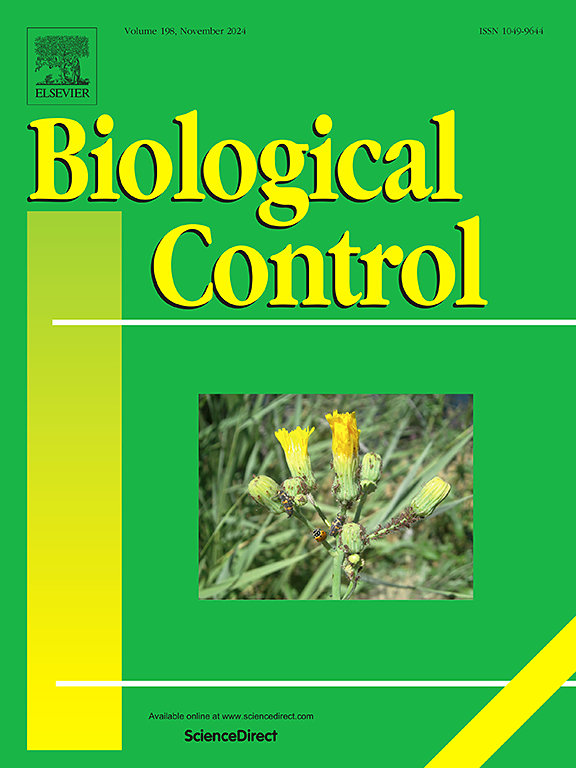IF 3.4
2区 农林科学
Q2 BIOTECHNOLOGY & APPLIED MICROBIOLOGY
引用次数: 0
摘要
步幅大蠹(半翅目:大蠹科)是影响东亚大豆种植的重要害虫。本研究通过室内和野外笼试验,评价了黄蜂(oencyrtus utetheisae,膜翅目:蜂科)对黄蜂的生物防治能力。测定了异色瓢虫侵害人卵的发育时间、寿命、繁殖率和功能反应。评价了不同龄期的异种姬蝇雌虫对不同龄期的步行纹田鼠卵的寄生影响。此外,还通过田间笼试验,评价了黄颡鱼卵对黄颡鱼卵的寄生率。未成熟寄生蜂的发育时间(从卵到成虫羽化)和成年雌寄生蜂的寿命均长于雄寄生蜂。平均每雌产卵量为56.9个,后代性别比为86.8%。平均每个红蜂卵中孵化出2.6只小黄蜂。寄生蜂的功能响应符合Holling的III型模型,在最佳寄主密度下,理论上每日最大寄生率为14.9个卵。对1 ~ 8日龄的黄纹天牛雌虫攻击1 ~ 3日龄的黄纹天牛卵的寄生率大于90%。在田间-笼试验中,以15(拟寄生虫):1(害虫)释放比,寄生率为47%。另外,白纹夜蛾雌虫用产卵器刺穿寄主卵,杀死22%的行纹夜蛾卵。上述结果表明,大黄麻作为一种生物防释剂具有很大的潜力。本文章由计算机程序翻译,如有差异,请以英文原文为准。
Controlling Riptortus pedestris (Hemiptera: Alydidae) using Ooencyrtus utetheisae (Hymenoptera: Encyrtidae)
Riptortus pedestris (Hemiptera: Alydidae) is an important pest that affects soybean cultivation in East Asia. In the present study, the ability of Ooencyrtus utetheisae (Hymenoptera: Encyrtidae) to provide biological control of R. pedestris was evaluated in laboratory and field-cage experiments. The developmental time, longevity, reproductive rate, and functional response of O. utetheisae attacking R. pedestris eggs were measured. The influence of parasitism by O. utetheisae females of different ages was assessed for R. pedestris eggs of different ages. In addition, rate of parasitism of R. pedestris eggs by O. utetheisae was evaluated in field-caged experiments. The developmental time of immature parasitoids (from egg to adult emergence) and adult female parasitoid longevity were longer than that of males. The average lifetime fecundity per female of O. utetheisae was 56.9 eggs, and the progeny sex ratio was 86.8% female. On average, 2.6 wasps emerged from each R. pedestris egg. The functional response of the parasitoid followed Holling’s Type III model, with a theoretical maximum daily parasitism rate of 14.9 eggs at an optimal host density per day. Parasitism was greater than 90% for 1–8 − day old O. utetheisae females attacking 1–3 − day old R. pedestris eggs. In field − cage trials, parasitism was 47% at 15 (parasitoid): 1 (pest) release ratio. In addition, O. utetheisae females killed 22% R. pedestris eggs by piercing host eggs with their ovipositors. These results indicated that O. utetheisae has significant potential as a biological control agent for augmentative release against R. pedestris.
求助全文
通过发布文献求助,成功后即可免费获取论文全文。
去求助
来源期刊

Biological Control
生物-昆虫学
CiteScore
7.40
自引率
7.10%
发文量
220
审稿时长
63 days
期刊介绍:
Biological control is an environmentally sound and effective means of reducing or mitigating pests and pest effects through the use of natural enemies. The aim of Biological Control is to promote this science and technology through publication of original research articles and reviews of research and theory. The journal devotes a section to reports on biotechnologies dealing with the elucidation and use of genes or gene products for the enhancement of biological control agents.
The journal encompasses biological control of viral, microbial, nematode, insect, mite, weed, and vertebrate pests in agriculture, aquatic, forest, natural resource, stored product, and urban environments. Biological control of arthropod pests of human and domestic animals is also included. Ecological, molecular, and biotechnological approaches to the understanding of biological control are welcome.
 求助内容:
求助内容: 应助结果提醒方式:
应助结果提醒方式:


